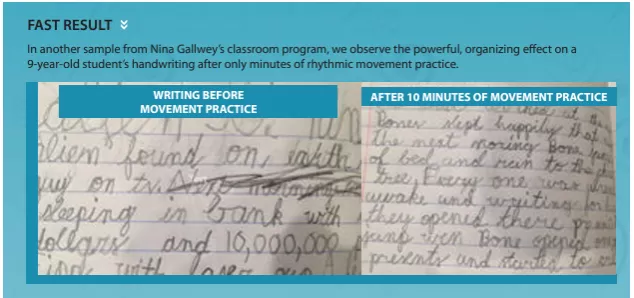Primitive Reflex Integration Case Studies
Improvements for an Entire Class—Reading, Speech, Handwriting, and More!
Teacher helps her students with consistent use of rhythmic movements.
See how weaving the use of rhythmic movements into a school environment made a difference for an entire class, including a student with selective mutism!
Submitted by Nina Gallwey, Remedial Education Teacher

| Before | After |
|---|---|
| Student struggled with selective mutism | Reading aloud in class; joined school's drama club |
| Challenges with fine-motor skills such as drawing and writing | Neater, more organized drawing and writing |
| Reading struggles | Every student reading at grade level |
Nina Gallwey, a remedial education teacher at Siskiyou School in Ashland, Oregon, offers this dramatic example of greater sensory maturity and coherence. Before participating in a movement program [from the Brain and Sensory Foundations program], the 8½-year-old student who drew these pictures [above] struggled with selective mutism. With regular rhythmic movement, this student’s strides amazed her speech therapist: She joined her school’s Drama Club and now reads aloud in class.
Here is another example of improved fine-motor skills in a different student:

An important part of Nina Gallwey’s program is consistent use of innate rhythmic and reflex movements. After two years under Nina Gallwey’s lead, every participant in her program for struggling students was reading at grade level.
*Disclaimer: The activities in the Brain and Sensory Foundations curriculum make use of the natural processes of neuroplasticity and development that are innately wired in the design of human beings to promote maturity and function. These activities appear to calm, organize, and mature the neuro-sensory-motor systems just as we see in the healthy development of human infants. Individual results may vary, and we do not claim to offer a diagnosis or cure for any specific condition or disorder. The Brain and Sensory Foundations activities appear to improve overall functioning resulting in measurable improvements for a range of conditions as demonstrated in over 1800 case studies from participants.

